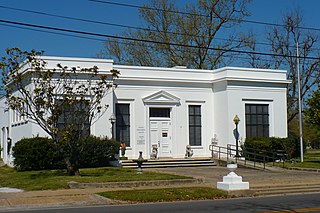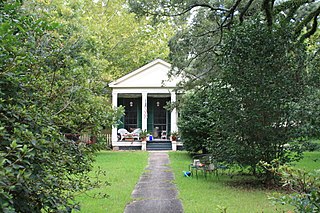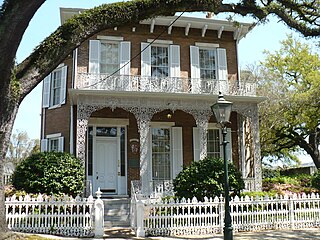
Mobile is a city and the county seat of Mobile County, Alabama, United States. The population within the city limits was 187,041 at the 2020 census, down from 195,111 at the 2010 census. After a successful vote to annex areas west of the city limits in July 2023, Mobile's population increased to 204,689 residents. It is now the second-most-populous city in Alabama, after Huntsville.

Fort Morgan is a historic masonry pentagonal bastion fort at the mouth of Mobile Bay, Alabama, United States. Named for American Revolutionary War hero Daniel Morgan, it was built on the site of the earlier Fort Bowyer, an earthen and stockade-type fortification involved in the final land battles of the War of 1812. Construction was completed in 1834, and it received its first garrison in March of the same year.

Fort Charlotte, Mobile is a partially-reconstructed 18th-century fort in Mobile, Alabama.

The National African American Archives and Museum, formerly known as the Davis Avenue Branch of Mobile Public Library, is an archive and history museum located in Mobile, Alabama. It serves as a repository for documents, records, photographs, books, African carvings, furniture, and special collections that relate to the African-American experience in the United States. Some of the collection was developed when the building was part of the Mobile Public Library as the Davis Avenue Branch.
The Old Dauphin Way Historic District is a historic district in the city of Mobile, Alabama, United States. It was named for Dauphin Way, now known as Dauphin Street, which bisects the center of the district from east to west. The district is roughly bounded by Broad Street on the east, Springhill Avenue on the north, Government Street on the south, and Houston Avenue on the west. Covering 766 acres (3.10 km2) and containing 1466 contributing buildings, Old Dauphin Way is the largest historic district in Mobile.

Montrose, also known as Sibley City, is an unincorporated community in Baldwin County, Alabama, United States along the eastern shore of Mobile Bay.

This is a list of the National Register of Historic Places listings in Mobile, Alabama.

The Gates–Daves House, also known as The Daves Place, is a historic residence in Mobile, Alabama. The one-story structure was built in 1841 with a Creole architectural influence, the best remaining example of its type in Mobile. It was placed on the National Register of Historic Places on June 20, 1974, due to its architectural significance.

The Amelia Stewart House, also known as the Carol O. Wilkinson House and William Hallett House, is a historic residence in Mobile, Alabama, United States. It was built in 1835, with a significant Greek Revival style addition to the front built in 1871. The house was placed on the National Register of Historic Places on May 29, 1992, based on its architectural significance.

The Ross Knox House is a historic Tudor Revival style residence in Mobile, Alabama, United States. The two-story brick and stucco house was completed in 1929. It is considered one of the best Tudor Revival houses in Mobile by the Alabama Historical Commission. Built in the 1920s upper-class suburb of County Club Estates, it was designed by architect John Platt Roberts.

The Roberts House is a historic Tudor Revival style residence and two dependencies in Mobile, Alabama, United States. Built in the 1920s upper-class suburb of County Club Estates, the complex was designed by J. F. Pate. The rambling two-story red brick mansion was completed in 1929. The exterior architecture features steeply pitched gables, prominent chimneys, casement windows, and an elaborate Tudor arch door surround.

The Protestant Children's Home, also known as the Protestant Orphans' Asylum, is a historic orphanage building in Mobile, Alabama, United States. It was placed on the National Register of Historic Places on June 18, 1973.
In 2015 the building was leased to the Infant Mystics society which began using it as a meeting lodge, renaming the place Cotton Hall.

The Robert L. Spotswood House, also known as the J. Clyde Glenn House, is a historic residence in Mobile, Alabama, United States. It was built in 1926 in the Spanish Colonial Revival style. The house was placed on the National Register of Historic Places on July 12, 1991, as a part of the Spanish Revival Residences in Mobile Multiple Property Submission.
The Hiram B. Austin House is a historic residence on Mon Louis Island in Mobile County, Alabama, United States. Situated on the western shore of Mobile Bay, the 1+1⁄2-story wood-frame structure was built in 1837 in the Gulf Coast Cottage style. It was placed on the National Register of Historic Places on February 11, 1988.

The Magee Farm, also known as the Jacob Magee House, is a historic residence in Kushla, Alabama, United States. Built by Jacob Magee in 1848, the 1+1⁄2-story wood-frame structure is an example of the Gulf Coast Cottage style. The house is best known as the site of preliminary arrangements for the surrender of the last Confederate States Army east of the Mississippi River. Confederate General Richard Taylor negotiated a ceasefire with Union General Edward Canby at the house on April 29, 1865. Taylor's forces, comprising 47,000 Confederate troops serving in Alabama, Mississippi and Louisiana, were the last remaining Confederate force east of the Mississippi River. The Magee Farm was placed on the National Register of Historic Places on February 11, 1988. In 2004, partially through the efforts of the Civil War Trust, a division of the American Battlefield Trust, which helped save 12.6 acres of the farm, the house was opened as a museum. It ceased operation as a museum in 2010, due to a lack of public support and declining revenues, and was listed for sale. It was then listed on the Alabama Historical Commission's Places in Peril listing for 2010.

Woodlands, also known as the Frederick Blount Plantation, is a historic plantation house in Gosport, Alabama. The house was added to the National Register of Historic Places on April 28, 1980, due to its architectural significance.

The Richards DAR House is a historic house museum in Mobile, Alabama, United States. The Italianate style house was completed in 1860 for Charles and Caroline Richards. It is a contributing property to the De Tonti Square Historic District, which was listed on the National Register of Historic Places on February 7, 1972. The four Daughters of the American Revolution (DAR) chapters in Mobile jointly operate and maintain the house. It is noted by architectural historians as one of Mobile's best preserved and elaborate examples of mid-19th century domestic architecture.

Spring Hill is a neighborhood of Mobile, in Mobile County, Alabama. Located on a tall broad hill 6 miles (10 km) to the west of downtown Mobile, it has one of the highest elevations in the area. Originally a summer retreat community, it was eventually encompassed and annexed by the City of Mobile after 1820. It gained its name from a number of natural springs at the site.

The John Archibald Campbell United States Courthouse, also known as the United States Court House and Custom House, is a historic courthouse and former custom house in Mobile, Alabama. It was completed in 1935. An addition to the west was completed in 1940. It was added to the National Register of Historic Places on October 8, 2008.






















